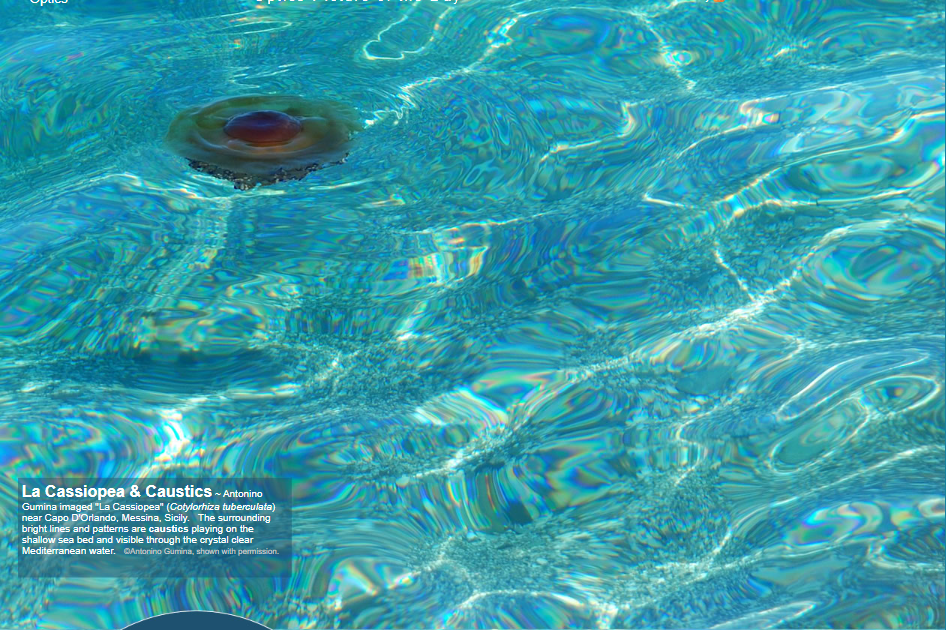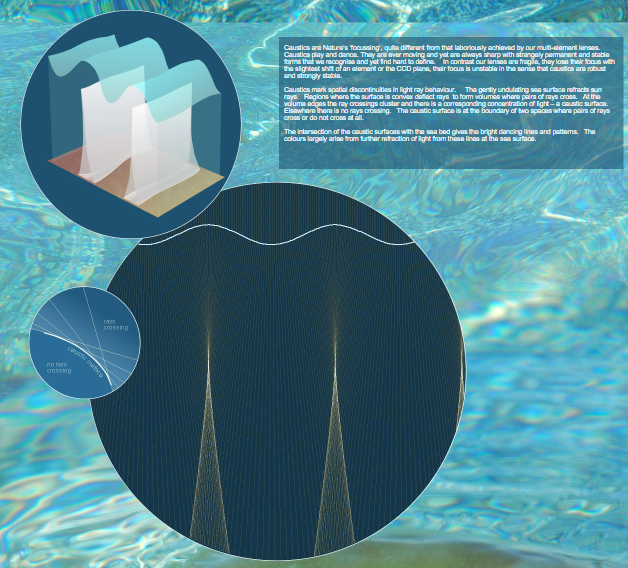OPOD - La Cassiopea & Caustics
OPOD - La Cassiopea & Caustics: A Fascinating Display of Nature's Focusing
In the mesmerizing world of atmospheric optics, there exists a captivating phenomenon known as caustics. Unlike the intricate mechanisms of our man-made lenses, caustics possess a unique quality of playfulness and movement. They are constantly in motion, yet their forms remain strangely permanent and stable, defying precise definition. In contrast to our delicate lenses, which lose focus with the slightest shift, caustics exhibit robustness and unwavering stability.
Caustics are the result of spatial discontinuities in the behavior of light rays. When sunlight interacts with the gently undulating surface of the sea, the rays undergo refraction. In regions where the sea surface is convex, the rays are deflected in a way that causes them to cross paths and form volumes. At the edges of these volumes, where ray crossings cluster, there is a concentration of light that gives rise to a caustic surface. In other areas, where no ray crossings occur, caustics are absent.
The interaction between these caustic surfaces and the sea bed creates a captivating display of bright lines and patterns. These lines are the visual representation of the caustics, with their colors largely arising from further refraction of light at the sea surface. As a result, the crystal clear waters of the Mediterranean become a canvas for nature's artistic expression, showcasing an enchanting interplay of light and form.
Antonino Gumina, an avid observer of atmospheric phenomena, captured one such breathtaking moment in his image titled "La Cassiopea." This image showcases the mesmerizing beauty of a Cotylorhiza tuberculata jellyfish gracefully gliding through the shallow waters near Capo D'Orlando, Messina, Sicily. The caustics surrounding the jellyfish add an ethereal quality to the scene, transforming it into a visual spectacle that is both captivating and thought-provoking.
To fully appreciate the wonder of caustics, it is essential to understand their significance in the realm of optics. Caustics serve as natural lenses, focusing light in a way that is distinct from the artificial lenses we create. While our lenses require intricate arrangements of multiple elements and are prone to losing focus with the slightest disturbance, caustics effortlessly achieve focus with their innate properties. They possess a stability and permanence that is unparalleled in the world of optics.
The unique nature of caustics raises intriguing questions about the fundamental behavior of light and its interaction with various mediums. Scientists and researchers have delved into the study of caustics to unravel the mysteries behind their formation and behavior. By understanding the intricacies of caustics, we gain valuable insights into the fundamental principles of optics and light propagation.
In conclusion, the mesmerizing dance of caustics on the sea bed offers a glimpse into the intricate workings of nature's focusing. Their ever-moving yet sharply defined forms bewitch our senses and challenge our understanding of light. Through their interaction with the sea bed, caustics create a visual symphony of lines and patterns that captivate our imagination. As we continue to explore the wonders of atmospheric optics, the enigmatic allure of caustics remains an enduring source of fascination and scientific inquiry.

La Cassiopea & Caustics ~ Antonino Gumina imaged "La Cassiopea" (Cotylorhiza tuberculata) near Capo D'Orlando, Messina, Sicily. The surrounding bright lines and patterns are caustics playing on the shallow sea bed and visible through the crystal clear Mediterranean water. ©Antonino Gumina, shown with permission.

Caustics are Nature’s ‘focussing’, quite different from that laboriously achieved by our multi-element lenses. Caustics play and dance. They are ever moving and yet are always sharp with strangely permanent and stable forms that we recognise and yet find hard to define. In contrast our lenses are fragile, they lose their focus with the slightest shift of an element or the CCD plane, their focus is unstable in the sense that caustics are robust and strongly stable.
Caustics mark spatial discontinuities in light ray behaviour. The gently undulating sea surface refracts sun rays. Regions where the surface is convex deflect rays to form volumes where pairs of rays cross. At the volume edges the ray crossings cluster and there is a corresponding concentration of light – a caustic surface. Elsewhere there is no rays crossing. The caustic surface is at the boundary of two spaces where pairs of rays cross or do not cross at all.
The intersection of the caustic surfaces with the sea bed gives the bright dancing lines and patterns. The colours largely arise from further refraction of light from these lines at the sea surface.
Note: this article has been automatically converted from the old site and may not appear as intended. You can find the original article here.
Reference Atmospheric Optics
If you use any of the definitions, information, or data presented on Atmospheric Optics, please copy the link or reference below to properly credit us as the reference source. Thank you!
-
<a href="https://atoptics.co.uk/blog/opod-la-cassiopea-caustics/">OPOD - La Cassiopea & Caustics</a>
-
"OPOD - La Cassiopea & Caustics". Atmospheric Optics. Accessed on November 29, 2024. https://atoptics.co.uk/blog/opod-la-cassiopea-caustics/.
-
"OPOD - La Cassiopea & Caustics". Atmospheric Optics, https://atoptics.co.uk/blog/opod-la-cassiopea-caustics/. Accessed 29 November, 2024
-
OPOD - La Cassiopea & Caustics. Atmospheric Optics. Retrieved from https://atoptics.co.uk/blog/opod-la-cassiopea-caustics/.